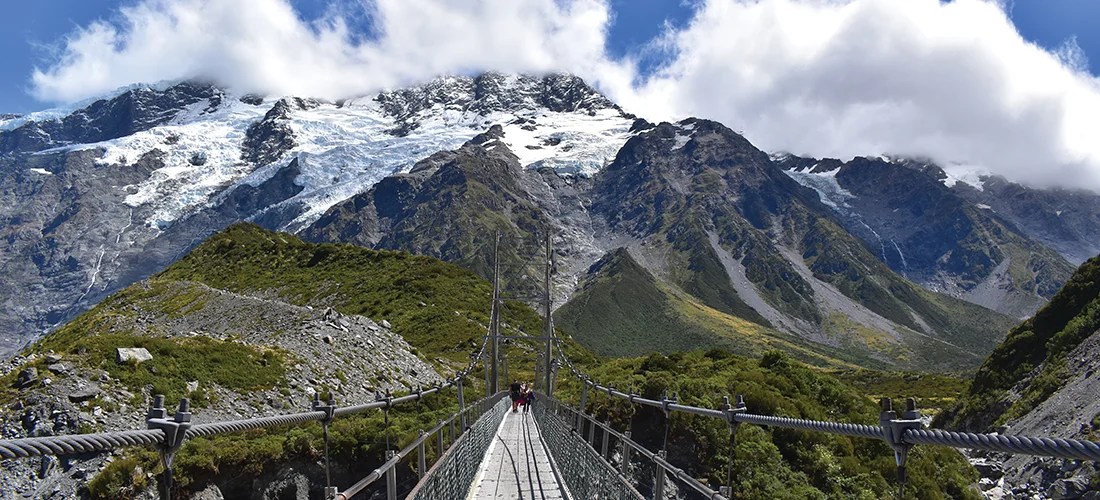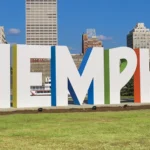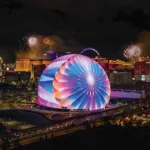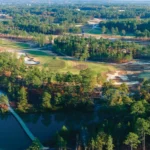Beauty & adventure in New Zealand
October 31, 2024

You’ve heard New Zealand is a destination for movie-worthy scenery. No wonder: Thirty percent of the country is national parks. (They aren’t crowded, either.) The country has half the population of North Carolina — and 24 million sheep. What’s the best way to experience the beauty of the Land of the Long White Cloud? A Charlotte mother and daughter share their contrasting ideas.
by Andrea Cooper and Laurel Tobias
Whale-watching, wineries, Māori culture and culinary delights
by Andrea Cooper
If skydiving, glacier hiking and bungee jumping aren’t your ideal vacation, why board a 14-hour flight to New Zealand, a mecca for adventure travel?
The island nation, known as Aotearoa in the indigenous Māori language, holds other pleasures. While visiting our daughter and son-in-law, who spent a year touring New Zealand in a campervan, we found it’s one of the most beautiful countries on the planet, with unusual animals and unreal views. Kiwis — the nickname for New Zealanders in honor of the flightless native bird — are polite and hospitable. The country boasts a fascinating Māori culture and a winemaking tradition to enjoy at day’s end.
Most international visitors fly into Auckland, home to a third of New Zealand’s population. The city has a cosmopolitan vibe in a waterfront setting with shops and restaurants near the Hauraki Gulf. Get a panoramic view by ascending Mount Eden, a dormant volcano whose summit overlooks the city. At the 200-acre Auckland Domain park, take in outdoor sculptures and native plants, including the spiraled silver fern often featured in Kiwi designs.
The Auckland Museum is an essential introduction to the country, particularly to Māori (say Mau-dee) culture. One standout among the taonga, or treasures, is the carved Māori guest house. During the Māori cultural experience, performed twice daily, indigenous artists tell stories and share the haka, a mesmerizing ceremonial dance.



Paragliding photograph by Laurel Tobias. Food photo by Camilla Rutherford, Tourism NZ Visual Library
You can swap learning for culinary pursuits and hop the 40-minute ferry to Waiheke Island, then rent a car, bike or e-bike to explore restaurants and wineries. Our tour started with a morning tasting overlooking the water at Mudbrick followed by lunch at Batch Winery, where the fare ranged from pumpkin gnocchi to New Zealand lamb. Afterward, we tooled around rolling hills and marveled at the colorful mosaics, reminiscent of Gaudí’s designs in Barcelona, at the restaurant and winery Casita Miro.
To reach our family on New Zealand’s South Island, we opted for the Northern Explorer train from Auckland to Wellington, followed by a ferry excursion the next morning. The daylong journey took us past sweeping farmland, river valleys and a volcano cone which doubled as Mount Doom in the Lord of the Rings movies. But it was the ferry excursion we’d do again tomorrow. Lush island mountains rose from the azure water, terns winged their way through the morning, and dramatic low clouds looked sculpted in the sky.
Our ferry threaded through Queen Charlotte (yes, that Queen Charlotte) Sound to the Picton port, where a coastal train sped us past black-sand beaches to one of our favorite places, Kaikōura. About two hours north of Christchurch, Kaikōura is known for wildlife.
We searched for sperm whales with Whale Watch Kaikōura. Everyone on board cheered when the crew spotted mist from a whale’s blowhole. We steered toward him, his back arching gracefully from the water, the mist catching light in rainbow hues. He lingered for about 20 minutes then dove, his tail rising high as a finale. Not long after, we happened on dozens of dusky, common and bottlenose dolphins. Some leapt into the air and belly flopped to stun fish below and grab dinner.
Back on land, we didn’t need an organized tour to find a colony of New Zealand fur seals along the craggy shoreline. They lumbered on the rocks and splashed in the water, undisturbed by our presence. That night we dined at Black Rabbit Pizza, where toppings include wild rabbit loin, venison, roasted goat and kangaroo.
Some outdoorsy travelers might be tempted to skip Christchurch. We were glad we visited its Willowbank Wildlife Reserve, where inhabitants range from cute wallabies (an invasive pest in the wild) to Sebastopol geese, whose ruffled feathers make them look like they got caught in a dryer. Other attractions include the Christchurch Botanic Gardens and Quake City, an exhibition from Canterbury Museum featuring survivors’ stories from the devastating 2010–2011 earthquakes.
Four hours west of Christchurch, we immersed ourselves in natural beauty. The 6-mile Hooker Valley Track in Aoraki/Mount Cook National Park is a highlight that’s attainable with a modest level of fitness. You’ll hike alongside a river and cross swinging bridges past stunning snow-capped mountains. The journey concludes with a spectacular glacial lake and Mount Cook before you.



View of Mount Cook from the Hooker Valley Trail by Thompson Bertschy, left. Doubtful Sound in Fjordland, top right, and a kea, a large parrot native to New Zealand, lower right. Photographs by Miles Holden, Tourism NZ Visual Library.
Lake Tekapo, roughly an hour away, is the place to encounter the world’s largest International Dark Sky Reserve. The two-hour Dark Sky Project tour positions guests at the apex of Mount John, where a guide uses hand-held lasers to introduce the stars in the Southern hemisphere. Telescopes reveal the Jewel Box Nebula, Southern Cross and Alpha Centauri.
The easygoing resort town of Wānaka, about two hours further south, feels like a New Zealand version of Asheville. Stroll around Lake Wānaka with views of Roys Peak and photograph the famed Wānaka Willow sprouting from the lake. Then spend the afternoon at the lake-to-plate restaurant Hook. You’ll get a fishing rod, bait and coaching on how to snag Chinook salmon in stocked ponds. The staff will prepare your catch, a sashimi or hot-smoked extravaganza that in our case fed four.
Once in Wānaka, you’ll be close to Queenstown, New Zealand’s adventure capital. But even for us sedentary types, it turns out a country more than 8,000 miles from home can be more accessible and compelling than expected.
IF YOU’RE GOING: Reaching New Zealand’s scenic spots will be much easier if you rent a car. Public transportation is limited in New Zealand. If you’re apprehensive about driving on the left side of the road, Kiwi Experience is among the companies offering small group tours. We found Airbnbs and motels available near all the places we visited.
Charlotte writer Andrea Cooper has written for National Geographic Traveler, The New York Times and other publications.
Backpacking, paragliding, caves and campervans
by Laurel Tobias
Kia ora – hello there, adventurous human. New Zealand is your place. My husband and I have been lucky to spend the last year here, and it’s been an ideal destination for our adrenaline cravings. We have paraglided next to the Southern Alps, floated past glow worms in an underground river, trekked several beloved Great Walks and skied beautiful snowy mountains, all in the span of several months. Most of these outdoorsy activities peak in spring through early autumn, which runs from November through March.
For an extended stay, I recommend renting a campervan. Campervans, about the size of an American SUV, typically sleep two to four people and let you wake up in a different place every day. Choose a “self-contained” one with a toilet, and you’ll gain access to free campsites throughout the country. We bought our van and have traveled for months in it.
Now you’re ready to experience one of New Zealand’s 10 Great Walks. These backpacking trips range from 20 to 50 miles and immerse you in the stunning scenery that lured filmmakers for The Lord of the Rings. Our favorite Great Walks include Tongariro Northern Circuit on the North Island and Milford Track on the South Island.



View of the author’s campervan at night, left, by Thompson Bertschy. Poor Knights Islands by Miles Holden, Tourism NZ Visual Library, top right. Dark Sky Reserve at Lake Tekapo by Thompson Bertschy, lower right.
At Tongariro, you’ll hike around Mount Ngauruhoe, an active volcano, and over the top of a mountain pass through strange volcanic formations. The landscape is dry but dotted with bright blue-green ponds and lakes that shine against the dark volcanic rock. Don’t touch the water: These lakes are tapu, or sacred. If you don’t have four days for the full circuit, single-day treks are possible.
To get to Milford on the South Island, you can take the ferry across Cook Strait with your van. It’s a long drive afterward — almost 13 hours from the ferry. Alternatively, you can fly into Queenstown and rent a campervan there for a much shorter 2 ½-hour drive to Lake Te Anau, the starting point for the Milford trek.
Near New Zealand’s southwestern coast in Fiordland National Park, Milford is nicknamed the finest walk in the world. Lush green mountains flank both sides of the valley and waterfalls roar all around you, if you’re lucky and get a good rain. The walk peaks (literally) on day three, where you summit McKinnon Pass and reach dramatic 360-degree alpine views. This hike is well worth the trip in rain, shine, wind and hail.
The Great Walks attract hikers from all over the world. Along with incredible views, we met fun quirky characters who kept us entertained, and travel buddies who quickly turned into (we hope) lifelong friends. Among our favorites were a group of Kiwi men in their 50s, each carrying a liter of whiskey for the journey.
The good news is, on these hikes, there’s no need to haul a tent: New Zealand’s Department of Conservation maintains nearly 1,000 huts to book for overnight lodging. The biggest ones sleep 50 or more, and all have stoves for preparing meals. Rangers share the history of the area, updates on the weather and what to expect on the track. Many Great Walks are not a loop, but you can arrange for a service to deliver your vehicle at the end.
Some other favorite New Zealand adventures are far above the ground. Paragliding is offered near the resort towns of Wānaka and Queenstown. My husband and I opted for Wānaka. Attached to our guides, we ran off a cliff together as our banana-shaped parachutes caught the wind and soared above the gorgeous Matukituki Valley and Lake Wānaka within sight of Aspiring National Park. Pro tip: If your guide asks whether you want a “crazy” trip, say yes to dip and weave through the air.


Left: Waitomo by Miles Holden, Tourism NZ Visual Library
If paragliding isn’t enough to get you going, try a rafting excursion more than 250 feet under ground. Local companies offer guided tubing through the glowworm caves in Waitomo on the North Island. Climb into a wetsuit and boots, jump into the cave opening with your tube, and float past thousands of tiny insects native to New Zealand with their distinctive turquoise glow. Crawling over rocks in the dark is part of the rush. On some trips, you can even jump off a subterranean waterfall.
If you’re keen on traveling during the summer (aka New Zealand winter), you’re still in luck. The skiing is thrilling, and both Cardrona and Treble Cone on the South Island offer options for skiers of all kinds, including newbies like me.
And there’s so much more to do: Canyoning, which combines rock climbing, swimming and rappelling. Heli-skiing, where you’re brought to a mountaintop by helicopter to ski your way down. Bungee jumping in the land where it began commercially. Biking across the South Island from the mountains to the coast. And of course, surfing next to dolphins in beautiful bays around the country.
No matter which activities you choose, on a New Zealand adventure, you’ll live life outside. That’s what makes it so magical.
IF YOU’RE GOING: Huts and transportation for the Great Walks must be booked months in advance. Book at the New Zealand Department of Conservation website. SP
Charlotte native Laurel Tobias is a child and adolescent therapist in Durham. See more of her New Zealand adventures on Instagram @hikin.and.goofin.
Featured image: Mount Cook/Hooker Valley Trail, photograph by Thompson Bertschy.





